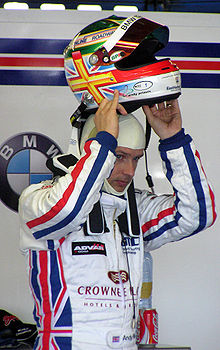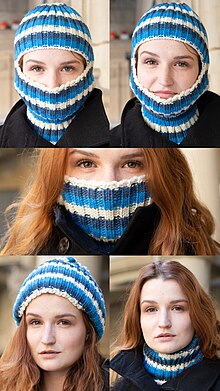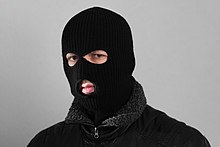Balaclava (hat)
A balaclava (also balaclava, ski mask, slip cap, hatred cap, balaclava, balaclava, Waq'ollo etc.) is the entire head and neck enveloping cap that either the face or even eyes leaves open and mouth. Versions that only leave the eyes open are rarer, e.g. B. the Roger Staub hat, named after its inventor, a Swiss ski racer. The additional designation owl describes models that leave each eye free, i.e. two holes. The name Balaclava used in the military arena comes from the Crimean War (1853-1856), where knitted hats of this type were given to the British troops for the first time against the climatic conditions of the Russian winter and named after the place on the theater of war Balaklava .
Cold protection
As protection against the cold in everyday life, the balaclava in Europe is largely only used for children in the face-free version (so-called hat or hooded hat). These hats are mostly knitted from wool, synthetic or mixed fibers . In recent years, adults have been increasingly using balaclavas in outdoor sports (e.g. mountaineering ); these are then mostly made of modern non-woven or composite materials with special insulating properties. Some balaclavas worn while riding a motorcycle have, in addition to their hygienic function (see below), reinforcements in the neck area to protect against wind.
When diving in cold water, so-called ice diving masks are used in order to expose as little skin area as possible to the coldness of the water. These are very similar in shape to the balaclava.
hygiene
When motorcycling and other motor sports, a balaclava is worn under the helmet, especially for hygienic reasons, because sweat cannot be removed from the helmet padding as easily as from the washable hood. The function of the hood is similar to that of socks in shoes.
Identity protection
Members of police and military special units wear balaclavas as identity protection when in action, whereby there is often a recess on the top of the head to ensure the function of a bone conduction microphone . The masks of the security forces usually do not have to provide protection against the cold and are therefore made of thin material. Often - sometimes improvised - balaclavas are also worn by terrorists and criminals .
In the 1980s, hoods and helmets were often used by autonomists at demonstrations to protect themselves from identification by police or political opponents. This led to the ban on masking . In connection with the use in milieus prone to violence, the term “hatred cap” has also become established for the type of hat.
The Anti-face veil law in Austria, actually as obfuscation ban intended, generally prohibits the partial or total concealment of the face in public places. Insofar as protection from the cold or health reasons for wearing are asserted, temperatures below zero or a medical certificate are required.
Fire protection

The term " flame protection hood " is used by the fire service . This hood is part of the respiratory protection equipment and serves to protect the skin from the effects of heat and fire, as in motor racing. The areas of the head that are not protected by a respirator or fire-fighting suit are covered by the flame protection hood .
In motor racing , the hood is part of the mandatory fire protection equipment and is worn under the helmet. The hood is then made of a fireproof fabric such as Nomex and is used to protect the face and neck from burn injuries. Depending on the design, only the eyes or the entire field of vision are cut out. The neck area is made longer so that it reaches under the collar of the overalls .
Flame hoods are also worn by soldiers on ships and tank crews to protect against the effects of flames after a hit by a ship-to-ship or air-to-ship missile or tank shell, since burns are the most common cause of injuries.
fetishism
In the fetish area , hand-knitted balaclavas made of natural fibers are mostly used today.
Peruvian folklore
In Peruvian folklore , knitted balaclavas called Waq'ollo play a role. Unlike the better-known chullo , they were not part of everyday clothing, but were initially only worn on the occasion of the Quyllur Rit'i snow star festival in the Cusco region, which lasted several days . The coloring is mostly rainbow-colored or white with rainbow-colored or black decorations and each with stylized facial features similar to a Guy Fawkes mask. As a typical souvenir, the Waq'ollo is spread internationally.
Definition of terms
Known as the balaclava cap is the same type of helmet balaclava , depending on the shape and Bascinet called to distinguish. In the Middle Ages, the hood-like headgear Gugel was also worn.
Web links
Individual evidence
- ↑ Balaclavas and hi-vis: we know what you'll be wearing next autumn / winter. The Guardian, archived from the original on June 18, 2018 ; accessed on June 28, 2019 .
- ↑ The Autonomous, the Unknown Being , Die Welt, June 24, 2007
- ↑ Clothing regulations on the website of the German Motorsport Association (PDF file; 320 kB)
- ↑ "Willy Warmer" & Co. - knitting for wool fetishists , Focus from August 31, 2008




